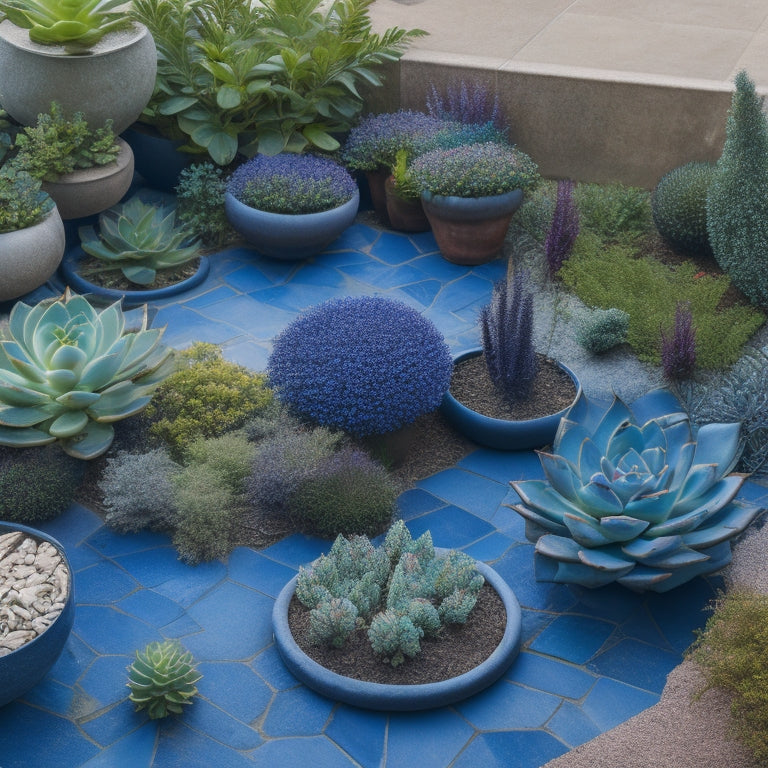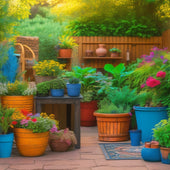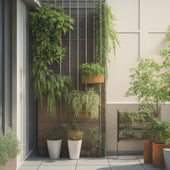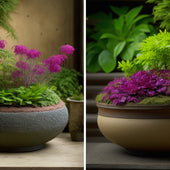
What Makes a Stunning Succulent Rooftop Garden Layout?
Share
By thoughtfully selecting a diverse range of succulents suited to your local climate and rooftop conditions, you'll set the stage for a stunning succulent rooftop garden layout. Consider the weight capacity and structural integrity of your rooftop, and choose a soil mix that drains efficiently and mimics the plants' natural habitats. Balance texture and color by combining plants with varying scales, shapes, and hues, and create focal points with statement pieces like aloe or agave. As you finesse your design, you'll uncover the secrets to a thriving, show-stopping oasis that reflects your personal style - and that's just the beginning of your rooftop garden journey.
Key Takeaways
• Select diverse, drought-resistant succulents suitable for local climate and rooftop conditions to ensure thriving plants.
• Design a visually appealing layout with varying scales, textures, and colors to create depth and interest.
• Balance sunlight exposure by assessing shade, monitoring intensity, and positioning plants for optimal morning sunlight.
• Create a focal point feature, such as a unique succulent species or decorative planter, to anchor the garden and draw attention.
• Combine gritty soil ingredients with organic matter and maintain proper watering schedules to promote healthy plant growth.
Choosing the Right Succulents
As you begin creating your stunning succulent rooftop garden, select a diverse range of succulents that thrive in your local climate and complement your desired aesthetic, from delicate, trailing sedums to bold, architectural echeverias.
Consider drought-resistant varieties that can withstand the intense sunlight and potential water scarcity on your rooftop. Native varieties are an excellent choice, as they're naturally adapted to your region's climate and require less maintenance.
When choosing succulents, think about the overall look and feel you want to achieve. Do you prefer a lush, verdant landscape or a more minimalist, modern design?
Select a mix of textures, colors, and shapes to create visual interest and depth. Don't forget to include a few statement pieces, like a show-stopping aloe or a dramatic agave, to add drama and personality to your garden.
Selecting a Suitable Rooftop Structure
Your rooftop's structure plays a crucial role in supporting your succulent garden, so it's important to evaluate its condition, ensuring it can handle the weight and waterproofing requirements of your new oasis.
You don't want your rooftop to collapse or leak, ruining your beautiful garden and potentially causing damage to your home.
Start by checking the rooftop stability, ensuring it can support the weight of the soil, plants, and any additional features like planters or seating areas.
Consider the load capacity of your rooftop, taking into account the weight of the materials you plan to use.
It's critical to consult with a structural engineer or a contractor to determine the maximum weight your rooftop can handle.
Additionally, inspect the rooftop for any signs of damage, such as cracks or rust, and address these issues before moving forward.
Designing for Climate and Sun
With your rooftop structure secure, you're ready to tailor your succulent garden design to the unique climate and sun patterns of your location, ensuring your plants receive the perfect balance of warmth and hydration.
Assess the sun exposure of your rooftop, considering the direction it faces and the surrounding buildings or structures that may cast shade. Succulents generally thrive in full sun to partial shade, but some species require more protection from intense sunlight.
When designing for climate adaptation, consider the average temperature, rainfall, and humidity levels in your area. Succulents are naturally adapted to arid environments, but they can still be sensitive to extreme weather conditions.
Choose species that are tolerant of your local climate, and group them according to their specific needs. For example, if you live in a hot and dry region, select succulents that can withstand high temperatures and infrequent watering.
Incorporating Visual Interest Elements
To elevate your succulent rooftop garden from a mere planting to a stunning visual experience, incorporate a variety of textures, colors, and forms that will captivate the eye and invite exploration. By doing so, you'll create a dynamic landscape that changes with the seasons.
Consider adding plants with varying scales, from tiny sedums to towering agaves, to create visual layers that add depth to your garden. Incorporate statement pieces like showy echeverias or architectural cacti to draw the eye and create focal points.
Don't forget to incorporate seasonal changes by adding plants that offer interest during different times of the year, such as spring-blooming succulents or autumn-colored grasses. As you design your garden, think about how the different elements will work together to create a cohesive look.
Balancing Texture and Color
As you design your stunning succulent rooftop garden, you'll want to balance texture and color to create a visually stunning space.
By combining contrasting leaf shapes, like rounded echeverias and spiky agaves, you'll add depth and interest to your garden.
Next, you'll choose a harmonious hue palette that complements your succulents' natural colors, ensuring a cohesive and enchanting look.
Contrasting Leaf Shapes
How do you envision combining succulents with dramatically different leaf shapes to create a visually striking rooftop garden that's both tactile and tantalizing to the eye?
By embracing leaf diversity, you can craft a succulent arrangement that's as intriguing as it's beautiful. Start by selecting succulents with varying leaf shapes, from the slender, pointed leaves of the Aloe aristata to the rounded, fleshy leaves of the Echeveria. The contrast between these shapes will create a captivating visual dynamic, drawing the viewer's eye through the arrangement.
To take your design to the next level, consider the texture and size of each succulent's leaves. Pair smooth, waxy leaves with those that are rough and ridged, or combine delicate, petite leaves with larger, more dramatic ones.
This shape contrast will add depth and interest to your rooftop garden, making it a true showstopper. By thoughtfully combining succulents with diverse leaf shapes, you'll create a rooftop oasis that's both a feast for the eyes and a haven for the senses.
Harmonious Hue Palette
You'll reveal the full potential of your succulent rooftop garden by curating a harmonious hue palette that thoughtfully balances texture and color, creating a visually stunning oasis that draws the eye and soothes the soul.
To achieve this, consider the principles of color psychology, which suggest that certain hues can evoke emotions and moods. For instance, calming blues and whites can promote relaxation, while vibrant oranges and yellows can energize and uplift.
When selecting your palette, think about the seasonal hues that will complement your succulents' natural colors. In spring, incorporate pastel shades to reflect the soft blooms of the season. Summer's warmth can be mirrored with bold, bright colors, while autumn's earthy tones will enhance the rich, jewel-toned succulents. In winter, icy blues and silvers can add a touch of serenity to your rooftop oasis.
Creating a Focal Point Feature
A striking succulent centerpiece or statement piece, carefully positioned to draw the eye, becomes the anchor that sets the tone for your entire rooftop garden. This focal point feature is the visual magnet that pulls everything together, creating a sense of cohesion and harmony.
When choosing focal point materials, consider unique succulent species, decorative planters, or sculptures that add texture and interest. You can also repurpose items like vintage containers or reclaimed wood to add a touch of personality to your rooftop oasis.
When it comes to focal point placement, think about the flow of your rooftop garden. Place your statement piece in a high-traffic area, like a seating nook or near a staircase, to create a sense of drama and visual appeal.
Consider the surrounding landscape and architecture, ensuring your focal point complements rather than clashes with its surroundings. By thoughtfully selecting and positioning your focal point feature, you'll create a rooftop garden that's both visually stunning and inviting – the perfect retreat to escape the hustle and bustle of everyday life.
Maintaining a Thriving Environment
As you work to maintain a thriving environment for your stunning succulent rooftop garden, you'll need to pay close attention to three key factors: ideal soil conditions, proper watering schedules, and balanced sunlight exposure.
By getting these elements just right, you'll create a haven where your succulents can flourish.
Optimal Soil Conditions
Create a soil mix that mimics the succulents' natural habitats by combining gritty, well-draining ingredients like perlite, vermiculite, or sand with organic matter like compost or peat moss. This blend will guarantee your succulents receive the right amount of moisture and aeration.
When choosing a soil type, consider a mix specifically designed for cacti and succulents, as they typically have better drainage solutions.
To further optimize your soil conditions, keep the following in mind:
-
Avoid using regular potting soil, as it can retain too much water and cause root rot.
-
Add a layer of small rocks or broken pottery at the bottom of your planters to improve drainage.
-
Use a soil pH tester to guarantee your mix is within the ideal range for succulents (slightly acidic to neutral).
-
Avoid over-tilling, as this can damage the soil structure and lead to erosion.
-
Consider adding a soil aerator to improve air circulation and prevent waterlogging.
Proper Watering Schedules
With succulents, you'll need to master the delicate art of watering, striking a balance between hydration and drought to foster a thriving environment. Overwatering can be detrimental, leading to root rot and plant decay. On the other hand, underwatering can cause stress, making your succulents more susceptible to pests and diseases.
To avoid these common pitfalls, establish a watering schedule tailored to your rooftop garden's specific needs. Consider factors like climate, soil type, and pot size to determine the ideal watering frequency.
| Watering Frequency | Soil Type | Climate |
|---|---|---|
| Daily | Sandy | Hot and dry |
| Every other day | Well-draining | Mild and sunny |
| 2-3 times a week | Moisture-retentive | Cool and cloudy |
| Weekly | Heavy clay | Cool and rainy |
| Bi-weekly | Cactus mix | Cold and snowy |
Implement drainage solutions, such as adding perlite or vermiculite to your soil, to prevent waterlogged soil. Additionally, incorporate moisture retention strategies, like mulching or using a humidifier, to maintain a stable moisture level. By finding the perfect balance, you'll create a thriving environment for your succulents to flourish.
Balanced Sunlight Exposure
By deliberately situating your rooftop garden in a spot that receives balanced sunlight exposure, you'll be nurturing an environment where your succulents can thrive, their vibrant colors and unique textures reaching their full capability. This means considering the orientation of your rooftop, taking into account the path of the sun throughout the day and throughout the year.
To achieve ideal sunlight exposure, keep the following tips in mind:
-
Assess shade considerations: Be aware of any obstructions, such as nearby buildings or trees, that may cast shade on your rooftop garden.
-
Make seasonal adjustments: As the sun's path changes with the seasons, adjust the positioning of your plants or use shade cloth to guarantee they receive the right amount of sunlight.
-
Monitor the intensity: Be mindful of the intensity of the sunlight, especially during peak summer hours, to prevent scorching or burning.
-
Provide morning sun: Succulents love morning sun, so try to position your plants to receive gentle morning sunlight.
-
Observe and adapt: Continuously observe your plants' response to sunlight exposure and make adjustments as needed to guarantee a thriving environment.
Frequently Asked Questions
How Often Should I Water My Succulent Rooftop Garden in Winter?
As winter's chill settles in, you'll want to water your succulent rooftop garden sparingly, about every 4-6 weeks, to prevent rot and guarantee succulent care, allowing roots to dry slightly between winter watering sessions.
Can I Mix Succulents With Other Types of Plants in My Rooftop Garden?
You can create stunning plant combinations by mixing succulents with other types of plants, but make certain design aesthetics align, and consider factors like sunlight, water, and maintenance requirements to guarantee a harmonious and thriving rooftop garden.
Do I Need to Add Fertilizer to My Succulent Rooftop Garden Regularly?
You'll be amazed to know that 75% of rooftop gardens lack essential nutrients, but don't worry! You can fix this by adding fertilizer to your succulent rooftop garden regularly, using balanced, water-soluble fertilizers applied through drip irrigation or foliar sprays for ideal results.
How Can I Protect My Succulent Rooftop Garden From Strong Winds?
You'll shield your rooftop oasis from strong gusts by incorporating wind barriers, like mesh screens or trellises, and choosing succulent varieties with sturdy stems and compact growth habits, ensuring your plants remain secure and thriving.
Can I Create a Succulent Rooftop Garden on a Pitched Roof?
You can create a stunning succulent rooftop garden on a pitched roof by prioritizing design considerations, incorporating drainage solutions, and ensuring secure planters to withstand wind and water flow, guaranteeing a safe and thriving oasis.
Related Posts
-

3 Best DIY Planter Ideas for Backyard Decor
You can elevate your backyard's style and functionality by choosing the right DIY planter ideas. Start with a mix of ...
-

3 Best DIY Planter Ideas for Backyard Decor
You can elevate your backyard's style and functionality by choosing the right DIY planter ideas. Start with a mix of ...
-

3 Best DIY Planter Ideas for Backyard Decor
You can elevate your backyard's style and functionality by choosing the right DIY planter ideas. Start with a mix of ...
-

3 Best DIY Planter Ideas for Backyard Decor
You can elevate your backyard's style and functionality by choosing the right DIY planter ideas. Start with a mix of ...
-

3 Best DIY Planter Ideas for Backyard Decor
You can elevate your backyard's style and functionality by choosing the right DIY planter ideas. Start with a mix of ...
-

3 Best DIY Planter Ideas for Backyard Decor
You can elevate your backyard's style and functionality by choosing the right DIY planter ideas. Start with a mix of ...
-

3 Best DIY Planter Ideas for Backyard Decor
You can elevate your backyard's style and functionality by choosing the right DIY planter ideas. Start with a mix of ...
-

3 Best DIY Planter Ideas for Backyard Decor
You can elevate your backyard's style and functionality by choosing the right DIY planter ideas. Start with a mix of ...
-

3 Best DIY Planter Ideas for Backyard Decor
You can elevate your backyard's style and functionality by choosing the right DIY planter ideas. Start with a mix of ...
-

3 Best DIY Planter Ideas for Backyard Decor
You can elevate your backyard's style and functionality by choosing the right DIY planter ideas. Start with a mix of ...
-

3 Best DIY Planter Ideas for Backyard Decor
You can elevate your backyard's style and functionality by choosing the right DIY planter ideas. Start with a mix of ...
-

3 Best DIY Planter Ideas for Backyard Decor
You can elevate your backyard's style and functionality by choosing the right DIY planter ideas. Start with a mix of ...
-

3 Best DIY Planter Ideas for Backyard Decor
You can elevate your backyard's style and functionality by choosing the right DIY planter ideas. Start with a mix of ...
-

3 Best DIY Planter Ideas for Backyard Decor
You can elevate your backyard's style and functionality by choosing the right DIY planter ideas. Start with a mix of ...
-

3 Best Space-Saving Gardening Ideas for Urban Renters
You can turn even the smallest urban space into a lush oasis by utilizing clever space-saving gardening ideas. Maximi...
-

3 Best Space-Saving Gardening Ideas for Urban Renters
You can turn even the smallest urban space into a lush oasis by utilizing clever space-saving gardening ideas. Maximi...
-

3 Best Space-Saving Gardening Ideas for Urban Renters
You can turn even the smallest urban space into a lush oasis by utilizing clever space-saving gardening ideas. Maximi...
-

3 Best Space-Saving Gardening Ideas for Urban Renters
You can turn even the smallest urban space into a lush oasis by utilizing clever space-saving gardening ideas. Maximi...
-

3 Best Space-Saving Gardening Ideas for Urban Renters
You can turn even the smallest urban space into a lush oasis by utilizing clever space-saving gardening ideas. Maximi...
-

3 Best Space-Saving Gardening Ideas for Urban Renters
You can turn even the smallest urban space into a lush oasis by utilizing clever space-saving gardening ideas. Maximi...
-

3 Best Space-Saving Gardening Ideas for Urban Renters
You can turn even the smallest urban space into a lush oasis by utilizing clever space-saving gardening ideas. Maximi...
-

3 Best Space-Saving Gardening Ideas for Urban Renters
You can turn even the smallest urban space into a lush oasis by utilizing clever space-saving gardening ideas. Maximi...
-

3 Best Space-Saving Gardening Ideas for Urban Renters
You can turn even the smallest urban space into a lush oasis by utilizing clever space-saving gardening ideas. Maximi...
-

3 Best Space-Saving Gardening Ideas for Urban Renters
You can turn even the smallest urban space into a lush oasis by utilizing clever space-saving gardening ideas. Maximi...
-

3 Best Space-Saving Gardening Ideas for Urban Renters
You can turn even the smallest urban space into a lush oasis by utilizing clever space-saving gardening ideas. Maximi...
-

3 Best Space-Saving Gardening Ideas for Urban Renters
You can turn even the smallest urban space into a lush oasis by utilizing clever space-saving gardening ideas. Maximi...
-

3 Best Space-Saving Gardening Ideas for Urban Renters
You can turn even the smallest urban space into a lush oasis by utilizing clever space-saving gardening ideas. Maximi...
-

3 Best Space-Saving Gardening Ideas for Urban Renters
You can turn even the smallest urban space into a lush oasis by utilizing clever space-saving gardening ideas. Maximi...
-

What to Seal Your Planters With for Longevity
When sealing your planters for longevity, it's vital to choose a sealant compatible with your planter material - whet...
-

What to Seal Your Planters With for Longevity
When sealing your planters for longevity, it's vital to choose a sealant compatible with your planter material - whet...
-

What to Seal Your Planters With for Longevity
When sealing your planters for longevity, it's vital to choose a sealant compatible with your planter material - whet...
-

What to Seal Your Planters With for Longevity
When sealing your planters for longevity, it's vital to choose a sealant compatible with your planter material - whet...
-

What to Seal Your Planters With for Longevity
When sealing your planters for longevity, it's vital to choose a sealant compatible with your planter material - whet...
-

What to Seal Your Planters With for Longevity
When sealing your planters for longevity, it's vital to choose a sealant compatible with your planter material - whet...
-

What to Seal Your Planters With for Longevity
When sealing your planters for longevity, it's vital to choose a sealant compatible with your planter material - whet...
-

What to Seal Your Planters With for Longevity
When sealing your planters for longevity, it's vital to choose a sealant compatible with your planter material - whet...
-

What to Seal Your Planters With for Longevity
When sealing your planters for longevity, it's vital to choose a sealant compatible with your planter material - whet...
-

What to Seal Your Planters With for Longevity
When sealing your planters for longevity, it's vital to choose a sealant compatible with your planter material - whet...
-

What to Seal Your Planters With for Longevity
When sealing your planters for longevity, it's vital to choose a sealant compatible with your planter material - whet...
-

What to Seal Your Planters With for Longevity
When sealing your planters for longevity, it's vital to choose a sealant compatible with your planter material - whet...
-

What to Seal Your Planters With for Longevity
When sealing your planters for longevity, it's vital to choose a sealant compatible with your planter material - whet...
-

What to Seal Your Planters With for Longevity
When sealing your planters for longevity, it's vital to choose a sealant compatible with your planter material - whet...
-

What to Seal Your Planters With for Longevity
When sealing your planters for longevity, it's vital to choose a sealant compatible with your planter material - whet...
-

What to Seal Your Planters With for Longevity
When sealing your planters for longevity, it's vital to choose a sealant compatible with your planter material - whet...
-

What to Seal Your Planters With for Longevity
When sealing your planters for longevity, it's vital to choose a sealant compatible with your planter material - whet...
-

What to Seal Your Planters With for Longevity
When sealing your planters for longevity, it's vital to choose a sealant compatible with your planter material - whet...
-

What to Seal Your Planters With for Longevity
When sealing your planters for longevity, it's vital to choose a sealant compatible with your planter material - whet...
-

What to Seal Your Planters With for Longevity
When sealing your planters for longevity, it's vital to choose a sealant compatible with your planter material - whet...
-

What to Seal Your Planters With for Longevity
When sealing your planters for longevity, it's vital to choose a sealant compatible with your planter material - whet...
-

What to Seal Your Planters With for Longevity
When sealing your planters for longevity, it's vital to choose a sealant compatible with your planter material - whet...
-

What to Seal Your Planters With for Longevity
When sealing your planters for longevity, it's vital to choose a sealant compatible with your planter material - whet...
-

What to Seal Your Planters With for Longevity
When sealing your planters for longevity, it's vital to choose a sealant compatible with your planter material - whet...
-

What to Seal Your Planters With for Longevity
When sealing your planters for longevity, it's vital to choose a sealant compatible with your planter material - whet...
-

What to Seal Your Planters With for Longevity
When sealing your planters for longevity, it's vital to choose a sealant compatible with your planter material - whet...
-

What to Seal Your Planters With for Longevity
When sealing your planters for longevity, it's vital to choose a sealant compatible with your planter material - whet...
-

What to Seal Your Planters With for Longevity
When sealing your planters for longevity, it's vital to choose a sealant compatible with your planter material - whet...
-

What to Seal Your Planters With for Longevity
When sealing your planters for longevity, it's vital to choose a sealant compatible with your planter material - whet...
-

What to Seal Your Planters With for Longevity
When sealing your planters for longevity, it's vital to choose a sealant compatible with your planter material - whet...
-

What to Seal Your Planters With for Longevity
When sealing your planters for longevity, it's vital to choose a sealant compatible with your planter material - whet...
-

What to Seal Your Planters With for Longevity
When sealing your planters for longevity, it's vital to choose a sealant compatible with your planter material - whet...


